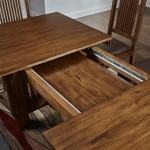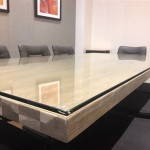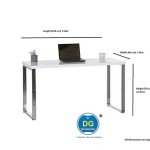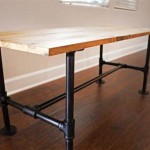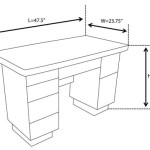Butcher Block Table Designs: A Guide to Functionality and Aesthetics
Butcher block tables have transitioned from their utilitarian roots in butcher shops to become highly sought-after features in modern homes. Their durable surfaces, warm aesthetics, and versatility make them ideal for kitchens, dining rooms, and even home offices. The design possibilities are vast, ranging from rustic farmhouse styles to sleek, contemporary interpretations. This article explores the key considerations in designing and choosing a butcher block table, focusing on various design elements and practical applications.
Understanding Butcher Block Construction and Wood Species
The term "butcher block" refers to a specific type of wood construction where multiple pieces of wood are joined edge-to-edge, end-to-end, or face-to-face to create a thick, durable surface. This construction method provides inherent strength and stability needed for heavy use, such as chopping, kneading, and preparing food. There are three primary types of butcher block construction:
Edge Grain: This is the most common type, where long, narrow pieces of wood are laid on their edges and glued together. Edge grain butcher blocks offer a good balance of durability and aesthetics, showcasing the long, continuous grain patterns of the wood. They are typically more affordable than other construction methods.
End Grain: In end grain construction, the ends of the wood pieces are exposed on the surface. This creates a visually striking "checkerboard" pattern and offers exceptional durability. End grain surfaces are self-healing to some extent, as the wood fibers can spring back from knife marks. Due to the more complex manufacturing process, end grain butcher blocks are usually more expensive.
Face Grain (or Wide Plank): Face grain butcher blocks are made by gluing wide planks of wood together, showcasing the wood's natural grain patterns. While visually appealing, this construction method is generally less durable than edge grain or end grain butcher blocks, as the glue lines are more susceptible to stress and moisture.
The choice of wood species significantly impacts the butcher block's appearance, durability, and maintenance requirements. Popular wood species for butcher block tables include:
Maple: A hard, dense wood known for its durability and light color. Maple is a popular choice for both edge grain and end grain butcher blocks.
Walnut: A hardwood with a rich, dark brown color and beautiful grain patterns. Walnut adds a touch of elegance and sophistication to any space, but it's generally softer than maple and requires more careful maintenance.
Cherry: A reddish-brown hardwood that darkens with age. Cherry is prized for its warm color and smooth texture. It's softer than maple and walnut, making it more prone to scratches and dents.
Oak: A strong and durable hardwood with a distinctive grain pattern. Oak is a classic choice for butcher block tables, offering a rustic and timeless appeal.
Birch: A hardwood with a light, creamy color and a fine grain pattern. Birch is a budget-friendly option that can be stained to match a variety of decor styles.
The selection of wood species hinges on balancing desired aesthetics with practical considerations like budget, durability, and maintenance factors.
Designing Butcher Block Tables: Style and Functionality
Butcher block tables can be incorporated into various interior design styles, from rustic farmhouse to modern minimalist. The design of the table should consider both the overall aesthetic of the space and the intended function of the table.
Table Shape and Size: The shape and size of the butcher block table should be determined by the available space and the number of people who will be using it. Rectangular tables are the most common choice, providing ample surface area for dining or food preparation. Round or oval tables can create a more intimate and inviting atmosphere. Square tables are suitable for smaller spaces or as accent pieces.
The size of the butcher block should correspond logically to the use-case. A small butcher block placed in a tight kitchen may suit someone who only needs to prepare meals occasionally. Conversely, a professional chef would need a larger, more robust butcher block table to handle the rigors of the kitchen.
Table Base and Legs: The table base significantly contributes to the overall aesthetic and stability of the table. Common options include:
Wooden Legs: Simple wooden legs can complement a rustic or farmhouse style. They can be straight, tapered, or turned for added visual interest.
Metal Legs: Metal legs provide a modern and industrial look. They can be made from steel, wrought iron, or aluminum and finished in various colors.
Pedestal Base: A pedestal base offers a clean and elegant look. It can be made from wood, metal, or stone and is ideal for round or oval tables.
Trestle Base: A trestle base provides a rustic and sturdy appearance. It consists of two or more vertical supports connected by a horizontal beam.
Custom Bases: Often, a combination of wood and metal provides a stylish and robust table design that fits well in contemporary homes. Designs can be customized, using software or even hand-drawn designs, and then sent to a metal worker for fabrication to suit the exact dimensions of the butcher block.
Table Height: The height of the butcher block table should be appropriate for its intended use. Standard dining tables are typically 28-30 inches tall. Counter-height tables are around 34-36 inches tall and are often used in kitchens for food preparation or as informal dining areas. Bar-height tables are 40-42 inches tall and are ideal for bars or high-top seating.
Edge Profiles: The edge profile of the butcher block table adds a subtle detail that can enhance its overall appearance. Common edge profiles include:
Square Edge: A simple and clean edge profile that is suitable for modern and minimalist designs.
Rounded Edge: A soft and comfortable edge profile that is ideal for dining tables.
Beveled Edge: An angled edge profile that adds a touch of sophistication.
Ogee Edge: A curved edge profile that is more ornate and traditional.
Live Edge: A natural and irregular edge profile that showcases the natural beauty of the wood.
Finishes: The finish applied to the butcher block table protects the wood and enhances its natural beauty. Common finishes include:
Mineral Oil: A food-safe oil that is used to protect and condition butcher block surfaces. Mineral oil needs to be reapplied regularly to maintain its protective properties.
Wax: A natural finish that provides a protective layer and adds a subtle sheen. Wax needs to be reapplied periodically.
Polyurethane: A durable and water-resistant finish that provides excellent protection against scratches and stains. Polyurethane is not food-safe and should not be used on surfaces that come into direct contact with food.
Varnish: Similar to polyurethane, varnish provides a durable and water-resistant finish. However, it is also not food-safe.
Food-Safe Finishes: These specialized finishes are designed for direct contact with food and offer both protection and safety. They typically consist of natural oils and waxes.
Practical Applications and Maintenance of Butcher Block Tables
Butcher block tables are incredibly versatile and can be used in a variety of settings. In the kitchen, they can serve as durable work surfaces for chopping, kneading, and preparing food. They can also be used as islands, peninsulas, or breakfast bars. In the dining room, butcher block tables provide a warm and inviting space for family meals and gatherings.
Beyond the kitchen and dining room, butcher block tables can also be used in home offices as desks or workstations. Their sturdy surfaces can support heavy equipment and provide ample space for spreading out documents. In living rooms, butcher block tables can be used as coffee tables or end tables, adding a touch of rustic charm to the space.
Proper maintenance is essential for preserving the beauty and longevity of butcher block tables. Regular cleaning with a mild soap and water solution is recommended. Avoid using harsh chemicals or abrasive cleaners, as they can damage the wood. To prevent staining, promptly wipe up spills. Regularly oiling the surface with mineral oil or another food-safe oil will help to keep the wood hydrated and prevent cracking.
For butcher block tables used for food preparation, it is important to sanitize the surface regularly to prevent the growth of bacteria. A solution of vinegar and water or a commercially available butcher block cleaner can be used for this purpose. To avoid cross-contamination, use separate cutting boards for raw meats and vegetables.
Scratches and dents can be removed with sandpaper. Start with a coarse grit sandpaper to remove the damage and then gradually move to finer grits to smooth the surface. After sanding, re-oil the surface to protect the wood.
Butcher block tables, when properly designed and maintained, can provide years of enjoyment and functionality. The selection of wood species, construction method, and finish should be carefully considered based on the intended use and aesthetic preferences. With regular care, butcher block tables will remain a beautiful and practical addition to any home.

How To Make A Butcher Block Table Simplified Building

Kitchen Island With Seating Option Storage Butcher Block Table Custom

How To Make A Butcher Block Table Simplified Building

How To Make A Butcher Block Table Simplified Building

How To Build A Butcher Block Table Out Of 2x4

2x4 Countertop Concept Reclaimed Wood Dining Table Butcher Block Rustic Furniture Design

Kitchen Butcher Block Table Eclectic Toronto By Coach House Antiques Houzz Ie

Kitchen Island Butcher Block Table Modern Mid Century Wood I Strong Oaks

5 Modern Conference Table Ideas Simplified Building

Walnut Butcher Block Countertop Console Table Dining With Live Edge China River Solid Wood Kitchen Tables Made In Com


